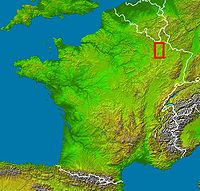
Woëvre
Encyclopedia


Natural region
A Natural region is one which is distinguished by its natural features of geography and usually more important, geology. The natural ecology of the region is likely to be significant but one of these factors tends to influence the others....
of Lorraine
Lorraine (région)
Lorraine is one of the 27 régions of France. The administrative region has two cities of equal importance, Metz and Nancy. Metz is considered to be the official capital since that is where the regional parliament is situated...
in northeastern France
France
The French Republic , The French Republic , The French Republic , (commonly known as France , is a unitary semi-presidential republic in Western Europe with several overseas territories and islands located on other continents and in the Indian, Pacific, and Atlantic oceans. Metropolitan France...
. It forms part of Lorraine plateau and lies largely in the department of Meuse
Meuse
Meuse is a department in northeast France, named after the River Meuse.-History:Meuse is one of the original 83 departments created during the French Revolution on March 4, 1790...
.
The Woëvre lies on the right bank of the Meuse River
Meuse River
The Maas or Meuse is a major European river, rising in France and flowing through Belgium and the Netherlands before draining into the North Sea...
, from the valley of the Chiers
Chiers
The Chiers is a river in Luxembourg, Belgium and France. It is a right tributary to the river Meuse. Its total length is about 130 km.The source of the Chiers is near Differdange, in Luxembourg...
in the north to the town of Neufchâteau
Neufchâteau, Vosges
Neufchâteau is a commune in the Vosges department in Lorraine in northeastern France.Inhabitants are called Néocastriens.-Geography:Positioned at the confluence of the Rivers Meuse and Mouzon, the little town dominates the Vosges Plain...
in the south. To the west, the region follows the Meuse, to the east it extends into the neighbouring department of Meurthe-et-Moselle
Meurthe-et-Moselle
Meurthe-et-Moselle is a department in the Lorraine region of France, named after the Meurthe and Moselle rivers.- History :Meurthe-et-Moselle was created in 1871 at the end of the Franco-Prussian War from the parts of the former departments of Moselle and Meurthe which remained French...
. The Lac de Madine
Lac de Madine
Lac de Madine is a lake at the border between Meurthe-et-Moselle and Meuse departments, France. At an elevation of 240 m, its surface area is 11 km²....
lies in the Woëvre as does the western part of the Parc naturel régional de Lorraine. Neighbouring natural regions include the Côtes de Meuse on the left bank of the Meuse, the Barrois
Barrois
Barrois is a "pays" in the eastern part of France. In the Middle Ages it was part of the duchy of Bar, then bordering the duchy of Lorraine. Today Barrois is a "pays" of the present-day Région Lorraine.-External links:*...
to the south, and the Côtes de Moselle to the east. The Belgian
Belgium
Belgium , officially the Kingdom of Belgium, is a federal state in Western Europe. It is a founding member of the European Union and hosts the EU's headquarters, and those of several other major international organisations such as NATO.Belgium is also a member of, or affiliated to, many...
Ardennes
Ardennes
The Ardennes is a region of extensive forests, rolling hills and ridges formed within the Givetian Ardennes mountain range, primarily in Belgium and Luxembourg, but stretching into France , and geologically into the Eifel...
lie to the north.
Along with the Côtes de Moselle, the Woëvre is one the of areas in the Lorraine that receives the least rainfall. Nonetheless, it river system is very important and feeds into the Lac de Madine
Lac de Madine
Lac de Madine is a lake at the border between Meurthe-et-Moselle and Meuse departments, France. At an elevation of 240 m, its surface area is 11 km²....
. Since the Middle Ages
Middle Ages
The Middle Ages is a periodization of European history from the 5th century to the 15th century. The Middle Ages follows the fall of the Western Roman Empire in 476 and precedes the Early Modern Era. It is the middle period of a three-period division of Western history: Classic, Medieval and Modern...
, inhabitants along part of this system have used earthen levees to create ponds used for aquaculture
Aquaculture
Aquaculture, also known as aquafarming, is the farming of aquatic organisms such as fish, crustaceans, molluscs and aquatic plants. Aquaculture involves cultivating freshwater and saltwater populations under controlled conditions, and can be contrasted with commercial fishing, which is the...
, which now provide important refuges for migratory birds.
The soil of this region includes layers of sandstone
Sandstone
Sandstone is a sedimentary rock composed mainly of sand-sized minerals or rock grains.Most sandstone is composed of quartz and/or feldspar because these are the most common minerals in the Earth's crust. Like sand, sandstone may be any colour, but the most common colours are tan, brown, yellow,...
and limestone
Limestone
Limestone is a sedimentary rock composed largely of the minerals calcite and aragonite, which are different crystal forms of calcium carbonate . Many limestones are composed from skeletal fragments of marine organisms such as coral or foraminifera....
acquifers separated by impermeable clay. This part of the Lorraine is particularly forested, particularly with oak trees.
Certain areas in the Woëvre are designated as "Zones naturelles d'intérêt écologique, faunistique et floristique" or ZNIEFFs, a designation that marks them as particularly important to the preservation of France's ecological heritage either because of the plants or animals they support, their ecological role, or their local or national importance. The Conservatoire des sites lorraines, created to protect endangered species, purchased most of these areas in 1994.

